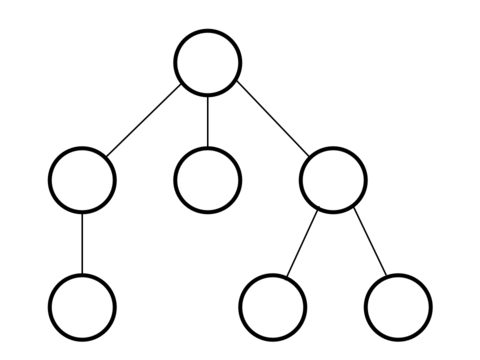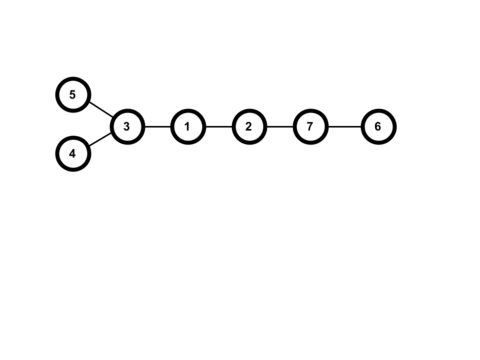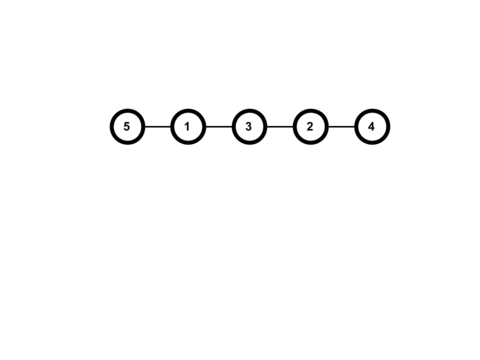CF1583B.Omkar and Heavenly Tree
普及/提高-
通过率:0%
AC君温馨提醒
该题目为【codeforces】题库的题目,您提交的代码将被提交至codeforces进行远程评测,并由ACGO抓取测评结果后进行展示。由于远程测评的测评机由其他平台提供,我们无法保证该服务的稳定性,若提交后无反应,请等待一段时间后再进行重试。
题目描述
Lord Omkar would like to have a tree with n nodes ( 3≤n≤105 ) and has asked his disciples to construct the tree. However, Lord Omkar has created m ( 1≤m<n ) restrictions to ensure that the tree will be as heavenly as possible.
A tree with n nodes is an connected undirected graph with n nodes and n−1 edges. Note that for any two nodes, there is exactly one simple path between them, where a simple path is a path between two nodes that does not contain any node more than once.
Here is an example of a tree:
 A restriction consists of 3 pairwise distinct integers, a , b , and c ( 1≤a,b,c≤n ). It signifies that node b cannot lie on the simple path between node a and node c .
A restriction consists of 3 pairwise distinct integers, a , b , and c ( 1≤a,b,c≤n ). It signifies that node b cannot lie on the simple path between node a and node c .
Can you help Lord Omkar and become his most trusted disciple? You will need to find heavenly trees for multiple sets of restrictions. It can be shown that a heavenly tree will always exist for any set of restrictions under the given constraints.
输入格式
Each test contains multiple test cases. The first line contains the number of test cases t ( 1≤t≤104 ). Description of the test cases follows.
The first line of each test case contains two integers, n and m ( 3≤n≤105 , 1≤m<n ), representing the size of the tree and the number of restrictions.
The i -th of the next m lines contains three integers ai , bi , ci ( 1≤ai,bi,ci≤n , a , b , c are distinct), signifying that node bi cannot lie on the simple path between nodes ai and ci .
It is guaranteed that the sum of n across all test cases will not exceed 105 .
输出格式
For each test case, output n−1 lines representing the n−1 edges in the tree. On each line, output two integers u and v ( 1≤u,v≤n , u=v ) signifying that there is an edge between nodes u and v . Given edges have to form a tree that satisfies Omkar's restrictions.
输入输出样例
输入#1
2 7 4 1 2 3 3 4 5 5 6 7 6 5 4 5 3 1 2 3 2 3 4 3 4 5
输出#1
1 2 1 3 3 5 3 4 2 7 7 6 5 1 1 3 3 2 2 4
说明/提示
The output of the first sample case corresponds to the following tree:
 For the first restriction, the simple path between 1 and 3 is 1,3 , which doesn't contain 2 . The simple path between 3 and 5 is 3,5 , which doesn't contain 4 . The simple path between 5 and 7 is 5,3,1,2,7 , which doesn't contain 6 . The simple path between 6 and 4 is 6,7,2,1,3,4 , which doesn't contain 5 . Thus, this tree meets all of the restrictions.The output of the second sample case corresponds to the following tree:
For the first restriction, the simple path between 1 and 3 is 1,3 , which doesn't contain 2 . The simple path between 3 and 5 is 3,5 , which doesn't contain 4 . The simple path between 5 and 7 is 5,3,1,2,7 , which doesn't contain 6 . The simple path between 6 and 4 is 6,7,2,1,3,4 , which doesn't contain 5 . Thus, this tree meets all of the restrictions.The output of the second sample case corresponds to the following tree:
